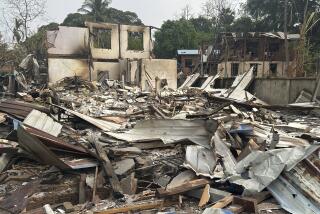Fighting Monks of Mandalay Battle to Save Myanmar
- Share via
MANDALAY, Mayanmar — Seven monks immortalized in a mural showing them lying in pools of blood are the predecessors of those known here as the fighting monks of Mandalay.
Venerable Ashin Kawwida, 45, leads a league of young Buddhist priests and proudly shows off the painting of the 1939 incident in which 17 demonstrators, including seven monks, were killed here in a turning point in Burma’s struggle for independence from Britain.
Monks are once again in the forefront and in their red robes have led marches in defiance of troops in full battle dress.
Their strength in Mandalay has made this northern city almost as important as the capital, Yangon, formerly Rangoon, in the Burmese people’s drive for democracy after 28 years of dictatorship.
In Yangon, soldiers outside opposition leader Aung San Suu Kyi’s home symbolize the tension and fear continuing in the capital despite her party’s landslide victory in general elections May 27.
The Buddhist clergy carries the banner for Mandalay.
In the former royal capital, about 400 miles north of Yangon, monks make up about 80,000 of the population of 600,000 and say they are watching to see if Myanmar’s ruling generals are serious about handing over power after the multiparty ballot.
The monks wield influence here. They ran Mandalay with students during August and September, 1988, when nationwide protests paralyzed a military-backed regime. The demonstrations were quashed by a coup on Sept. 18 that year.
“During the incidents, because of the taking charge by the monks, there was no destroying, no killing,” Kawwida said.
The bespectacled clergyman, clad only in sandals and a robe draped over one shoulder, said demonstrations are not possible now.
“We are oppressed. Our eyes are closed, our ears and also our mouths. We have no right to do what we think.
“We have to fear the actions of the authorities concerned,” he said.
His group, the All Myanmar Yahanpyo (Young Monks) League, was founded in 1938 with 20,000 members.
Its headquarters at the base of the stairway to the pagodas of Mandalay Hill was closed from 1965 to 1984 by the regime of strongman Gen. Ne Win.
“We are very worried because there is a feeling that the time to hand over state power is being delayed. People will wait about six months, and then explosion,” he said through an interpreter.
A group of monks in their 20s said they were following their elders’ advice for now but were “ready to use violence.”
“We can sacrifice by changing our robes into civilian dress,” said one young monk in the group, who asked that their names not be used.
The monks said the lesson they learned in 1988 was political.
“Before, our teaching was only religious. In 1988, we learned politics,” one of them said.
It was a painful process. Monks were killed in army crackdowns in 1988, although the exact number was not clear. Three monks are now in prison in Mandalay, one of the young monks said.
The monks also learned that soldiers, who they thought were Buddhists, would shoot at clergy.
“They shot only after the military coup,” according to one monk.
“We have no weapons, had no weapons at that time, not even a pencil sharpener, but our goodwill to the people makes them willing to fight,” another said.
The importance of the Buddhist clergy in Mandalay comes from a unique situation.
“You know, there are so many monks and students, so many places to meet together,” one of the young monks said. “In Rangoon, they don’t have a place to meet and so don’t trust one another.”
He said people are now “out in the country organizing.”
“We don’t feel we are free. We won the elections but there still is a curfew, there still is military rule.”
People are afraid of rules and new decrees, but “as monks we can speak freely. We have nothing to lose, no family and no jobs,” one monk said.
More to Read
Sign up for Essential California
The most important California stories and recommendations in your inbox every morning.
You may occasionally receive promotional content from the Los Angeles Times.













